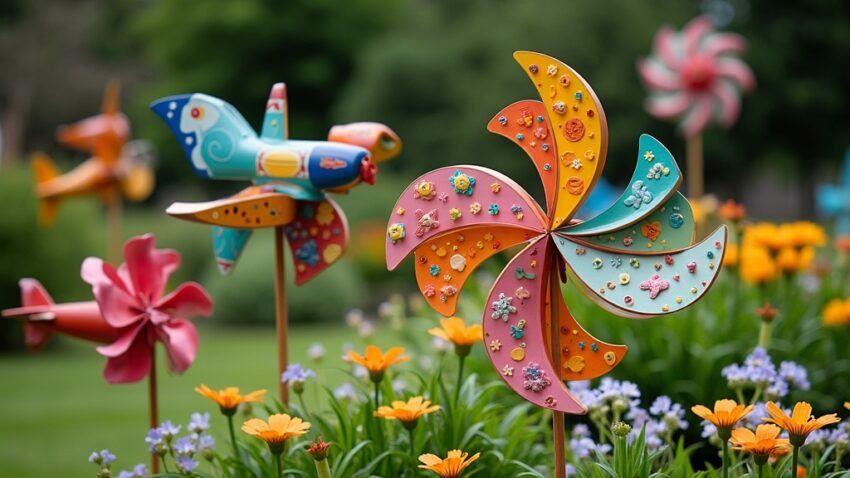If you’ve ever been mesmerized by a spinning garden sculpture or wondered about those quirky, moving contraptions catching the breeze, you’re probably looking at a whirligig. Artistic Whirligigs: Combining Craftsmanship And Creativity perfectly captures the magic of these pieces, where clever craftsmanship meets imaginative design, adding playful energy to gardens, patios, and even indoor spaces. I’ve spent years making and admiring these kinetic art pieces, and there’s a lot to love about how traditional skills and original ideas come together in every whirligig.
What is a Whirligig?
A whirligig is a moving object, most often with parts that spin or twirl when caught by the wind. You’ve probably seen ones shaped like airplanes, birds, people, or abstract designs. These whirligigs are all powered by breezes or even by hand. Whirligigs don’t just spin in place; many are built to act out scenes or tell tiny stories when the wind blows. The creativity in their design is a big part of what makes them much-loved additions to yards and art collections. Sometimes, sitting in a garden watching a whirligig whirl away can be a surprisingly calming way to spend an afternoon. The playful energy and animations they bring are also conversation starters for guests and neighbors alike.
The Origins of Whirligigs: Where Craft Began
Whirligigs have been around for a long time. Historians have found evidence of spinning toys and decorations in ancient Greece and China, dating back at least a couple thousand years. Some of the earliest were simple pinwheels for children made from parchment or feathers. As the concept traveled, folks started building more complex versions.
During the Middle Ages in Europe, whirligigs became more common as wind-driven objects. They really took off in American folk art during the 18th and 19th centuries. Farmers and craftspeople across rural North America started crafting them by hand. It didn’t take long before whirligigs became known for their quirky humor and inventive designs. By the 19th century, whirligigs had become a popular symbol of rural home life and creativity, showing up on barns, homes, and public squares.
What Were Whirligigs Originally Used For?
The first whirligigs weren’t just for fun. Some early designs served practical purposes, like scaring birds away from crops, serving as weather vanes, or helping track wind direction and speed. Others acted as noisemakers to ward off pests or unwelcome animals. Some even functioned as super simple toys or adornments that brought movement to homes and villages.
Eventually, their playful, animated qualities stole the show. People loved how motion could tell a story or get a laugh, and whirligigs switched from useful tools to works of folk art—sometimes both at once. Even today, you’ll spot whirligigs in gardens where they serve as playful lawn art while still helping keep curious critters away. Many gardeners like them for their dual purpose: amusing displays and basic animal deterrents.
Main Types of Whirligigs
Whirligigs come in more shapes and styles than I could possibly list, but here are a few of the most common and creative types:
- Classic Pinwheels: These are the ones you remember from childhood. They’re lightweight, colorful, and quick to spin, usually planted right into the soil or a flowerpot for a fun splash of movement outdoors.
- Mechanical Figurines: Picture a farmer chopping wood or a fisherman reeling in a catch. Cleverly geared, these whirligigs act out scenes when their blades catch the wind, enchanting both kids and adults with their simple animations.
- Animal or Bird Whirligigs: Birds flap, dogs wag tails, and ducks paddle their feet, all because of the spinning wind vane above. These are super popular with wildlife lovers and add a fun touch to any garden with their familiar figures.
- Abstract Art Whirligigs: These skip the figurative stuff and focus on eye-catching shapes, color patterns, or surprising motion, often doubling as kinetic sculptures and making a visual statement in any setting.
- Weather Vanes with Motion: Some weather vanes get decked out with extra moving pieces, blending function and kinetic art in imaginative ways.
Other types you might spot include musical whirligigs that chime or whistle, and thematic whirligigs created to honor local festivals or holidays. Some artists jump into custom projects, designing whirligigs that reflect personal hobbies or stories for collectors and clients.
Materials and Craftsmanship: Whirligigs as Art
The base material for most whirligigs is wood. It’s easy to carve, shape, and paint, making it the top choice for traditional makers. Cedar, pine, and plywood work great for outdoor pieces because they handle weather well with just a bit of paint or protection. Metal parts show up often, especially for rods and pivots, since they’re sturdy and handle the wind and rain over years outdoors. For really long-lasting outdoor whirligigs, recycled plastic is handy, too—it doesn’t rot, and you can find bright colors to work with.
What I love most is how artists experiment with materials. You’ll find whirligigs that use bits of glass, found objects, bicycle parts, or old tools. The style and personality of the artist really come through in how they choose and work with these items. Painting and detailed carving bring extra style, turning simple objects into true works of kinetic art. Some creators even include LED lights or solar elements to make their whirligigs glow after sunset, adding a bit of next-level cool to the night garden.
The finishing touches—like weatherproof varnishes, hand-painted scenes, or burnished metal—help whirligigs stand up to the elements and add to their eye-catching appeal. The careful attention to detail in the painting and construction transforms them from backyard trinkets into display-worthy pieces of moving folk art.
How Complex Can Whirligigs Get?
Complexity in whirligigs is all about creativity and engineering muscle. Some are super simple, like a single propeller that spins with the wind. Others are wildly intricate, with multiple moving figures, gears, levers, and linkage systems.
Some of the advanced whirligigs use wind power to trigger entire scenes; think a band playing or a whole train moving along a tiny track. There are even whirligigs built with counterweights, cams, and sophisticated mechanics for synchronized motion. Building these complicated pieces takes a blend of mechanical skill and a feel for fine art. If you’re looking to start out, basic designs are pretty approachable, but you’ll see your designs grow in complexity as you experiment and learn new tricks.
Many modern artists try mixing in electronics—think solar-powered motors or LED accents—creating kinetic sculptures that move on calm days or light up at night. Some larger whirligigs, installed in public spaces, weigh hundreds of pounds and require engineering to keep them twirling safely in strong winds. With a bit of ingenuity, almost any movement or story can come to life through a whirligig’s spinning parts and clever attachments.
Still Spinning: Whirligigs in Today’s World
Whirligigs enjoy a loyal following these days, both as collectibles and DIY projects. You’ll find them at craft fairs, public parks, in modern sculpture gardens, and online marketplaces. Whole festivals celebrate whirligig artists, with some towns even setting up permanent whirligig parks. Wilson, North Carolina, for example, hosts a huge display of wind-powered sculptures that attract visitors year-round (Wilson Whirligig Park).
Modern makers are bringing together oldschool woodworking with new materials and tech, creating solar-powered whirligigs or massive kinetic art installations for city centers. Whirligigs have also popped up as DIY kits for families or classrooms, giving kids a hands-on way to learn about weather, engineering, and art all at once. Some designers have started offering online workshops and tutorials, making it easy for anyone to jump into this creative hobby from home.
Collectors and museums sometimes track down rare or unusual antique whirligigs to display, showing how these animated pieces have found a place in both folk art history and cutting-edge sculpture. The popularity of whirligig-making communities online proves this folk art form is alive and spinning, with hobbyists trading patterns, tips, and stories in every corner of the world.
Tips for Designing Your Own Whirligig
Getting into whirligig making can be as simple or as detailed as you’d like. Here are a few suggestions if you’re thinking about building your own:
- Start with a simple propeller or pinwheel style. Fewer moving parts mean it’s easier to get the hang of balance and assembly for your first try.
- Choose weather-resistant materials if you want your whirligig to live outdoors. Painted cedar or lightweight metals will help your creation last longer through rain and sun.
- Pay attention to balance. If one side is heavier, your whirligig won’t spin as smoothly. Adjust the weight with washers, pennies, or trimmed material as needed.
- Use sealed bearings or bushings for moving joints. This keeps your project spinning smoothly for years and reduces maintenance.
- Let your creativity lead the way! Even scraps from old projects or fun thrift store finds can make for the most memorable parts.
- Sketch out your ideas before you build. Even a quick drawing can help you picture how the pieces will come together.
- Try a few color combinations or paint styles to make your whirligig really pop in the garden. Bright contrasting paints and bold shapes are more visible from a distance.
When you finally set your homemade whirligig spinning in the wind, that rush of satisfaction is something special. Don’t stress if your first few attempt aren’t perfect—every creative ride is about learning and experimenting. Trade photos and ideas with fellow makers, and watch as your skills grow along with the complexity of your builds.
Common Questions About Whirligigs
What is a whirligig?
A whirligig is a wind-powered object that spins or creates motion, often acting out scenes or bringing decorative movement to gardens and outdoor spaces.
When and where were whirligigs invented?
Simple wind toys go back thousands of years, with ancient examples in Greece and China. The modern style of hand-crafted, detailed whirligigs came together in Europe and North America over the last 300 years.
What were the original purposes of whirligigs?
Early whirligigs chased birds and pests away, tracked wind direction, and amused kids as toys. Over time they evolved into kinetic art with playful motion and storytelling features.
What are the different types of whirligigs?
Common types include classic pinwheels, mechanical figurines, animal shapes, abstract kinetic art, and motion-packed weather vanes.
What materials are used to make whirligigs?
Wood, metal, recycled plastics, found objects, and glass all show up in these creations. The choice comes down to durability, looks, and creative vision.
How complex can a whirligig be to build?
Some whirligigs stay simple with one or two moving parts. Others get quite technical, using gears, levers, and multiple animated sections.
Are whirligigs still popular today?
Absolutely. Artists, collectors, and DIY fans continue to design, build, and display whirligigs in yards, public spaces, and festivals around the globe.
Bringing Creativity Into Motion
Artistic whirligigs are a welcoming blend of engineering, storytelling, and art, turning simple wind into moving displays of creativity. Whether your style is rustic, modern, quirky, or refined, making or owning a whirligig is a chance to watch imagination spin into life every windy day. Their ongoing popularity and endless design possibilities mean there’s always a fresh way to join in and set your own story into motion. Next time you pass a garden dotted with spinning sculptures, take a closer look—you might just stumble upon your next creative hobby.

